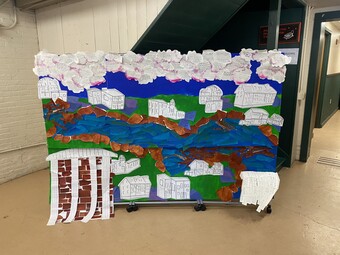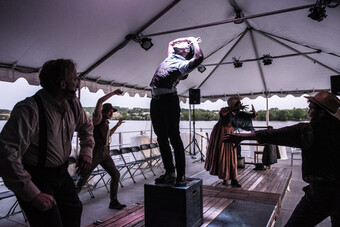On Immersive Theatre
The Senses to Take the Wall Down—Part 5: Estimation and Taste
A six-part series on the words, challenges, craft, and zeitgeist of the immersive theatre movement.
Every year at Thanksgiving a member of my family (which has its own breed of insanity) turns to me and says, “When are you going to make a play about this?” There is an organized epic chaos in the threads that tie together family and of course, the organizing principle is food. The taste of turkey and my mother’s stuffing bring us together. We break bread together as a ritual. It binds us more every year. We sit around a table and we eat. Yes, we are related, but the truth is that there is something freeing that happens between groups of people who have broken bread with each other.
The physical experience of taste. Tasting is different than eating. We can taste sweat. We can taste the oregano in a dish. We can taste the familiar combination of ingredients in our favorite pie. The thing to explore here is how taste comes before and in a separate way from a physical acceptance or digestion of a meal.
Let’s look at taste alongside estimation, as we know there is the other definition of the word taste, which is more closely linked to estimation—how we judge something, our preferences. If I am to put something in my mouth and find it unpalatable, I may never eat it again. If I am to put something in my mouth and find it intriguing, I may try it again. But if I put something in my mouth and it is everything, I will crave the taste. I will crave the food.
The tasting of something is biological and intimate. Our taste buds are a part of the sensory experience, but swallowing something is separate from the tasting process. It is an acceptance.
This metaphor has something to do with the reason I have seen people have hugely conflicting responses to immersive work: either an addiction or repulsion. Open-frame work struggles when it stands up to critique. The act of “immersion” itself seems to be under fire or lauded instead of the craft of the work. Part of my goal in this dialogue has been to instigate a way for a true critical discourse that does not just ooh and ahh over the fourth wall disappearing act. Let’s consider a critique of a work as if the fourth wall is already down. Let’s consider how well the piece leads the audience. Let’s consider how clearly the relationship is crafted upon entry. Let’s consider the use of different sensory designs and where this has been missed. In this way—we could begin to critique the work. Not judge the form by our taste.
I believe, however, that this puts ownership on the open-frame maker as well. We have to acknowledge that the experience of this work can create stress in an audience. They don’t know what to expect or how to behave. Ideally the answer to that question is different each time and led by the production. But the maker has to remember that some people just don’t like celery. I hate the taste of celery. I know intellectually it is not an offensive taste. I know that it is cooked into my mothers stuffing, something I love with all of my heart. But if someone brings celery and puts it in my face, I just don’t have a taste for it.
[caption]
My mom, my uncle, and her stuffing in the background.[/caption]But if I really beat this metaphor to death, the importance here in our critical thinking is that celery is in my beloved stuffing! I have read two or three ignorant articles this year on why people don’t like interactive or immersive theatre. The ignorance is not that they don’t like it—it is that they are judging the work on bad interactive and immersive theatre. They are taking one significant element and defining a massive body of work. Fine—we must accept that not all open-frame work can be my mothers stuffing. But then what do we do with this reaction as open-frame makers and thinkers?
We recognize that if we want this work to sustain the current fad, we must really invest in our true intention behind the work. The tasting of something is biological and intimate. Our taste buds are a part of the sensory experience, but swallowing something is separate from the tasting process. It is an acceptance. In this series, I have begun to define: open-frame, immersive, immersive storytelling, interactive, interactive storytelling, and invitation to the audience. In this forum I have only had the opportunity to introduce the thinking around the difference in these terms. I have also referred to intention: an established word in our theatremaking for defining character.
However, intention in the theatremaker is imperative in this open-frame work, as I believe it correlates directly to the way in which the audience is granted rules and goals in their own experience. It specifies the character or role of the audience. I believe this is the link. We know the classic need to determine intention of a character. If the audience is a character in some way and if we are asking of them to participate in a way that is new, we must be deeply, deeply clear about that intention and build everything around the work to support it. That is the craft.
Sure, this leads to a myriad more questions. And if we are to look at intention of the maker correlating with the goals for the audience, the question becomes how do we rehearse? How do we tech? What does tech mean? How do we estimate the experience of performance in this work? How do we create the script? How do we get the intention to the audience?— that is where the craft of this lies. Like the stuffing, that obsession is where we may begin to get our critics to eat celery.









Comments
The article is just the start of the conversation—we want to know what you think about this subject, too! HowlRound is a space for knowledge-sharing, and we welcome spirited, thoughtful, and on-topic dialogue. Find our full comments policy here
Loved this. Thanks for sharing!
thanks lovely.
very well said.
Thanks so much Cheryl